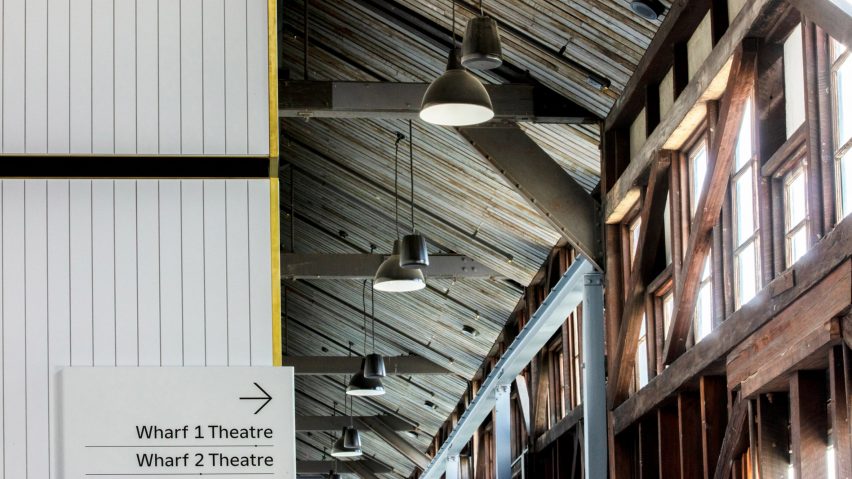Australian architecture studio Hassell has renovated a theatre in a former wool warehouse on Sydney Harbour to modernise its facilities while emphasising the 100-year-old building's history.
Expanded performance spaces, a new back-of-house corridor and improved accessibility are among Hassell's additions to the Sydney Theatre Company's Wharf building, which is part of a complex of timber "finger wharves" in Walsh Bay on Sydney Harbour.
Formerly used for wool storage, Wharf 4/5 was given over to the Sydney Theatre Company (STC) in the 1980s, and although much loved by both theatre-makers and the public, the building was in need of modernisation.
Hassell worked with theatre consultants Charcoalblue and heritage conservation architects Tropman & Tropman on the renovation, known as the STC Wharf Renewal Project.
The architecture studio aimed to improve the internal circulation of the building while maintaining the "all-under-one-roof" philosophy, where the entire creative process — from playwriting to set-building, management, marketing, archives, rehearsals and performance — take place in the Wharf.
To take advantage of the width of the building, which was previously under-utilised, Hassell removed a 1980s concrete fire tunnel that ran down the centre of the building, instead adding safe exits onto the concrete apron surrounding the building.
"One of the big strategies was, how can we open up access to the full width of the finger wharf?" said Scott.
"It freed up the whole shell of the heritage wharf," he continued. "By removing the fire tunnel, moving the programme, centring it, it freed up circulation in both directions, and the operations of the whole STC were greatly improved."
Removing the tunnel opened up east-to-west operational circulation and meant Hassell could add a back-of-house corridor along the western wall, with tall doors enabling full-height sets to be moved from the workshop to the theatres.
Previously, back-of-house staff had to circulate through several rooms to install sets, which had to be dismantled into pieces first, costing time and money.
Hassell also created space by raising the ceiling above the theatres and workshop, allowing more room for the state-of-the-art theatrical rigging system and seating.
This was possible because the original roof has two peaks – by raising only the section in the valley between them, the alteration is visually hidden externally, in line with heritage protection requirements.
The Wharf's two theatres were remodelled to increase their capacity, remove obstructive columns and make them adaptable to any performance.
Wharf 1, with a capacity of 350-420, has flexible seating offering three main configurations — End On, Corner and In the Round — while Wharf 2 has retractable seating and a capacity of 160.
There is also the option to retract the concertina skyfold doors separating the two theatres, combining them into one larger "Wharf 3".
These features allow the theatre to be converted into rehearsal or multipurpose space in under an hour and facilitate immersive or experimental styles of performance.
"Flexibility in theatre is really important at this scale," Gavin Green, co-founder or theatre consultants Charcoalblue, told Dezeen.
"You want your audiences to come in and with every visit feel that there's something unique about it."
"The world is being influenced by Punchdrunk and Secret Cinema, and practitioners are responding to that and trying to actually get a few steps ahead and offer something different."
The second aim of the renovation was to increase access to the heritage spaces while being clear which elements were historic, which from the 1980s and which were new.
Principal architect Glenn Scott said they were effectively working to preserve two layers of heritage: the original ironbark timber wharf and the conversion by architect Vivian Fraser.
"One of the things that the STC wanted was to acknowledge that piece of work from the '80s going forward into the new work, that somehow what was loved about it would continue on," Scott told Dezeen.
When it came to choosing materials, Hassell wanted to recall the white volumes of the earlier conversion but add more depth than came from the flat, painted plasterboard.
They chose fine-grooved timber panels with a slightly glossy white finish, to contrast against the raw and unfinished nature of the heritage timber on the ceiling and floor.
There is a similar contemporary quality to the balustrades and handrails, made of thin white steel rods.
Meanwhile, the theatres have been finished with Blitz Total Sealer, a paint product developed in-house at the STC by head of scenic art Neil Mallard when the pandemic limited imports.
Other additions to The Wharf include a recording studio, vocal coaching rooms and a function room, while both rehearsal rooms and offices have more floorspace.
Improved access comes from two additional public lifts and one new goods lift and upgraded assistive listening systems.
The Wharf reopened in February after the two-and-a-half-year renovation.
Elsewhere in Australia, Hassell recently completed the WA Museum Boola Bardip and is collaborating with Rogers Stirk Harbour + Partners and Weston Williamson on the design of five new metro stations in Melbourne.
Photography is by Brett Boardman.

